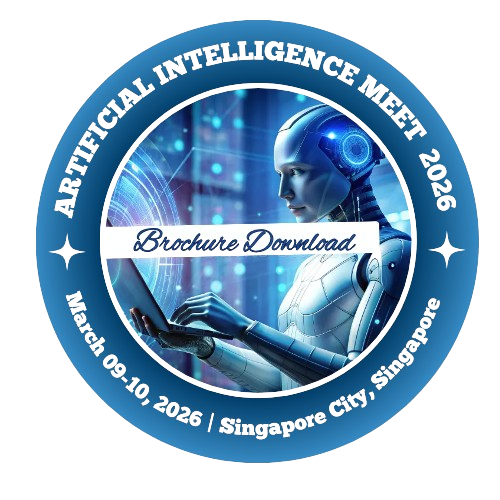Welcome message:
Welcome to the 14th Global Summit on Artificial Intelligence & Neural Networks (Artificial Intelligence Meet 2026), taking place on March 09–10, 2026, in the vibrant city of Singapore. This year’s theme, “Smarter, Faster, Ethical -The Next Evolution of AI and Neural Network Intelligence,” reflects our commitment to driving responsible innovation and advancing the future of intelligent technology. This prestigious global summit serves as a premier platform for AI researchers, technology innovators, data scientists, neural network experts, industry leaders, academic scholars, and students to connect, collaborate, and explore transformative breakthroughs shaping the next era of artificial intelligence.
Through an engaging blend of keynote talks, panel discussions, oral and poster presentations, workshops, and networking sessions, participants will gain access to the latest trends, emerging technologies, real-world case studies, and ethical frameworks that define the rapidly evolving AI landscape.
Whether you are presenting your research, seeking global visibility, exploring partnerships, or enhancing your professional knowledge, this summit offers an unforgettable and transformative experience. All registered participants will receive an official certificate of participation or presentation, endorsed by our organizing committee. Be part of the next chapter in AI innovation. We look forward to welcoming you to Singapore for an inspiring and impactful global gathering.
Target Audience:
-
Researchers and Scientists
-
Professors, Engineers and Students
-
Smart Innovators
-
Architectures
-
Software Developers
-
Data labelling professionals
-
Robotic Technologist
-
Computer vision engineers
-
Defence Research Professionals
-
Artificial Intelligence hardware specialists
-
Data protection specialists
-
Automation Industry Leaders
-
Gaming Professionals
-
Managers & Business Intelligence Experts
-
Advertising and Promotion Agency Executives
-
Artificial Intelligence in health care professionals
About conference:
Conference Series proudly welcomes global participants to the 14th Global Summit on Artificial Intelligence and Neural Networks, scheduled to be held in Singapore City, Singapore, on March 09–10, 2026. This year’s focus, “Smarter, Faster, Ethical — The Next Evolution of AI and Neural Network Intelligence,” highlights the rapid advancements in AI while emphasizing the importance of responsible and ethical innovation.
Join us at Artificial Intelligence Meet 2026 for an immersive two-day experience featuring a diverse range of sessions, including oral presentations, poster sessions, workshops, symposiums, and keynote addresses from world-renowned experts and industry pioneers in artificial intelligence and neural networks. The conference is designed to facilitate learning, networking, idea exchange, and collaboration among researchers, technologists, industry leaders, policymakers, and students.
We invite you to explore our registration options and secure your participation in this dynamic and insightful global gathering.
Why Attend the Conference?
Artificial Intelligence (AI) continues to reshape industries and redefine what possible advancing healthcare diagnostics is, enabling autonomous systems, and driving a future where intelligent machines perform tasks beyond human capability. AI encompasses a diverse range of fields, including Neural Networks, Machine Learning, Robotics, Evolutionary Computation, Computer Vision, Speech Processing, Expert Systems, Planning, and Natural Language Processing.
This conference aims to unite researchers, academicians, industry leaders, and scientists from the global AI and Neural Networks community to share knowledge, showcase research, and discuss emerging trends. It provides a dynamic platform to explore technological breakthroughs, scientific advancements, and evolving regulatory frameworks influencing the future of artificial intelligence.
What You’ll Gain
-
Cutting-Edge Content: Access the latest research findings, innovations, and industry trends in Artificial Intelligence and Neural Networks.
-
Networking Opportunities: Connect with professionals from academia, research institutions, and industry to build meaningful collaborations.
-
Professional Growth: Enhance your expertise through workshops, interactive sessions, and expert-led discussions.
-
Global Perspectives: Hear from international speakers and participants and gain diverse insights into AI development and implementation.
-
Interactive Engagement: Participate in live Q&A sessions, hands-on workshops, and roundtable discussions for deeper learning.
-
Poster Sessions: Explore innovative research presented by both emerging scholars and renowned experts.
-
Cultural Experiences: Discover the rich heritage and vibrant culture of Singapore through organized tours and social events.
-
Exhibition Hall: Experience the latest technologies, tools, and solutions from top companies shaping the future of Artificial Intelligence and Neural Networks.
Sessions & Tracks
The computing landscape is rapidly evolving with advanced technologies designed to streamline and enhance human tasks. However, many current systems still lack personalization, adaptability, and self-learning capabilities. Smart Agent technologies and other AI-powered innovations are emerging to overcome these challenges, offering improved efficiency and intelligent performance.
Predictive modeling uses mathematical and statistical techniques to forecast future events or outcomes by analyzing existing data patterns. As a core component of predictive analytics, it enables organizations to anticipate behavior, trends, and outcomes, supporting strategic decision-making and future planning.
A Digital Avatar is an AI-powered, human-like virtual assistant that facilitates intelligent interactions with customers. 3D avatars serve various purposes, fostering trust by making communication more direct and accessible. Their presence on different platforms is crucial, as they convey professionalism. A digital human that effectively communicates a company's values in a personalized manner can transform visitors into loyal customers. Creating a comprehensive avatar involves several steps, which can be broken down into five key stages.
The ethics of computing refers to the branch of technology ethics focused on robots and other artificially intelligent beings. It is typically divided into two main areas: robo-ethics and machine ethics. Robo-ethics concerns the ethical behavior of humans in designing, building, using, and interacting with artificially intelligent beings. It explores issues related to responsibility, fairness, and the impact of AI on society. Machine ethics, on the other hand, focuses on the ethical behavior of artificial agents themselves, addressing questions of moral decision-making, autonomy, and the responsibility of AI systems in carrying out tasks.
-
Robo-Ethics
-
Machine Ethics
With the growing use of AI, cybersecurity challenges have also evolved. While AI can strengthen digital defense systems, it may also be exploited for cyberattacks. AI-based cybersecurity solutions help detect, prevent, and respond to threats with advanced screening tools, fraud prevention systems, and automated attack detection.
Artificial intelligence in healthcare is a broad term used to describe the application of machine learning algorithms and software to simulate human knowledge in the analysis, interpretation, and understanding of complex medical and healthcare data. Specifically, AI refers to the ability of computer algorithms to make predictions or decisions based on data.
The primary goal of AI in healthcare is to analyze the relationships between clinical practices and patient outcomes. AI is applied in various areas, including:
-
Treatment protocol development
-
Drug development
-
Personalized medicine
-
Patient monitoring
Machine learning is one of the most exciting technologies, enabling computers to learn how to perform tasks without being explicitly programmed and to improve automatically through experience using algorithms. It is a branch of computing related to statistical methods, focusing on making predictions using computers. However, not all machine learning is based on mathematical learning. Machine learning facilitates the continuous evolution of computing by exposing systems to new situations, testing, and adapting. It leverages pattern and trend detection to enhance decision-making for future outcomes. Key applications of machine learning include:
Robotics and Mechatronics focus on the practical application of existing systems and control strategies. Artificial intelligence is concerned with the design, development, operation, and use of robots, including robot control systems, sensory feedback, and processing. Mechatronics spans various fields, including robotics, computing, telecommunications, and product development, combining elements of software, physics, and mechanical design. Key areas of Mechatronics include:
-
Nano robotics
-
Machine vision
-
Automation and robotics
-
Engineering cybernetics
AI in bioinformatics encompasses both basic and clinical research, utilizing techniques such as biological sequence matching, protein-protein interaction, and function-structure analysis. This research plays a crucial role in drug design and the exploration of complex systems. Bioinformatics is one of the key contributors to the recent advancements in computing. The primary goals of bioinformatics are:
-
To manage data in a way that facilitates easy access to existing information and allows for the addition of new entries as they are generated.
-
To develop technological tools that aid in the analysis of biological data.
Natural Language Processing (NLP) focuses on developing systems that enable computers to communicate with individuals using everyday language. It is broadly divided into two categories: Natural Language Understanding (NLU) and Natural Language Generation (NLG). NLG involves converting information from computer data into clear human language, while NLU interprets and understands human language inputs.
Key components and applications of NLP include:
With advancements in security technologies, biometric security systems have emerged as a significant upgrade, involving the design and implementation of sensors along with their supporting hardware and software. These systems have achieved remarkable technological advancements and widespread adoption. However, skepticism and concerns about privacy and reliability persist globally.
Biometric security systems are commonly applied in areas such as face recognition and biometric attendance tracking in organizations. Key features and examples include:
Artificial intelligence (AI) is already being utilized in various applications, and its influence on how people create and consume music is growing rapidly. With the development of AI tools and protocols for audio mastering, tuning, and streaming, AI has emerged as a solution to the increasing demand for music production. As a result, it is likely to have a profound impact on the creative processes of musicians. In the future, artists may need to possess advanced technical knowledge, including insights into neuroscience, to fully integrate AI into their craft.
Web-based training (WBT) is a form of computer-based learning that relies on an internet connection to deliver content and facilitate communication. Rooted in the principles of distance learning, WBT typically eliminates the need for face-to-face interaction between learners (or trainees) and instructors. This method of training has gained significant popularity due to the widespread availability of internet access and the interactive potential it offers. The two-way flow of information enabled by the internet creates an effective environment for training and education. By utilizing the web as a delivery platform, WBT maximizes opportunities for peer interaction and engagement with the learning system.
Most web-based training programs are designed to leverage these possibilities to enhance understanding and learning outcomes. Key elements and concepts associated with WBT include:
Artificial neural networks (ANNs) are based on the idea that they can mimic the structure and function of biological neurons by using hardware components, such as circuits and wires, to replicate neurons and dendrites. These networks aim to collaborate with the human brain by forming appropriate connections. An artificial neural network is a computational model inspired by biological principles, consisting of processing units (nodes), connections, and algorithms for training and recall. Various types of neural networks exist, including Feedforward ANN, Feedback ANN, Learning Vector Quantization, and others.
Key concepts and models related to neural networks include:
In today’s gaming industry, artificial intelligence (AI) has significantly enhanced both gameplay experience and design. AI-powered features and applications in video games have transformed various aspects of gaming, making them more engaging and immersive. These advancements help sustain players' interest and satisfaction over extended periods. AI often operates through mechanisms that are not directly visible to the user, such as data mining and procedural content generation, which work behind the scenes to optimize the gaming experience.
Key AI applications in gaming include:
Deep learning, also known as deep structured learning, is a subset of machine learning focused on learning data representations. It typically utilizes gradient descent for training through back propagation. The architecture of deep learning involves multiple layers, including hidden layers in artificial neural networks and sets of propositional formulas. A Deep Neural Network (DNN) is an artificial neural network with multiple hidden layers between the input and output layers. DNN architectures create hierarchical models where an object is represented as a layered composition of simpler elements. These networks are often feed forward neural networks, where data flows from the input layer to the output layer without feedback loops.
Applications of deep learning include:
-
Automatic Speech Recognition
-
Image Recognition
-
Visual Art Processing
-
Natural Language Processing (NLP)
Convolutional Neural Networks (CNNs) are specialized types of multilayer perceptrons, which are fully connected networks where each neuron in one layer is connected to all neurons in the next layer. CNNs are most commonly used in deep learning for visual image analysis. They are widely applied in tasks such as image and video recognition, recommender systems, image classification, medical image analysis, language processing, and financial analytics.
Key concepts and applications of CNNs include:
Cloud computing is a branch of information technology that provides on-demand access to shared pools of virtualized computing resources. These clouds can support various workloads, enabling rapid scaling and deployment using physical or virtual machines. They are self-healing, support redundancy, and employ highly scalable programming models, while also allowing for hardware/software rebalancing and failure mitigation.
In the context of cloud computing, artificial intelligence plays a crucial role in enhancing resource management, ensuring transparent distribution, and enabling measurable openness. By working in synergy, AI and cloud computing are poised to significantly shape the future of data technology.
Key types of cloud computing include:
The study of patterns and regularities in data is a fundamental aspect of machine learning, with pattern recognition being a prominent application. This involves using supervised learning algorithms to develop classifiers trained on data from various object categories. Supervised pattern recognition enables applications such as optical character recognition (OCR), face detection, face recognition, object detection, and object classification. In contrast, unsupervised learning identifies hidden structures within data using clustering techniques.
Feature selection, also known as variable selection, is the process of identifying a subset of relevant features for model development. It helps reduce overfitting, shorten training times, and simplify models for better interpretability by eliminating unnecessary or redundant features with minimal or no loss of information.
Key phases in pattern recognition include:
-
Learning Phase
-
Prediction Phase
Ambient Intelligence (AmI) refers to the integration of computing devices into environments that adapt intelligently and sensitively to the presence and needs of individuals. These environments are designed to consider people's preferences, specific requirements, and predictive behaviors. AmI can be applied in various settings, such as homes, offices, conference rooms, schools, management centers, and vehicles. The primary objective of AmI research is to enhance the intelligence of these environments, enabling seamless interaction and providing users with the necessary information to make informed decisions.
Key features of Ambient Intelligence include:
-
Embedded (integrated into the environment)
-
Context-Aware (responsive to situational changes)
-
Personalized (tailored to individual preferences and needs)
As global environmental challenges grow, Artificial Intelligence is becoming a powerful tool for climate prediction, sustainable development, and environmental protection. This track focuses on AI solutions for renewable energy optimization, carbon footprint reduction, smart agriculture, climate-risk forecasting, and policy modeling to support a resilient and sustainable planet.
-
Climate modeling and prediction systems
-
AI for renewable energy management
-
Smart agriculture and precision farming
-
AI for carbon emission tracking and reduction
-
Eco-automation and sustainable smart cities
Human-Centered AI & Cognitive Computing explores how AI can be designed to collaborate more naturally with people aligning technology with human psychology, cognition, trust, and emotional intelligence. It focuses on making AI explainable, intuitive, ethical, and emotionally intelligent.
Market Analysis
Artificial Intelligence Market: Size and Trends
The global artificial intelligence (AI) market was valued at USD 196.63 billion in 2023 and is expected to grow at a CAGR of 36.6% from 2024 to 2030. Continuous innovation by tech giants drives AI adoption across industries like automotive, healthcare, retail, finance, and manufacturing. For example, Google LLC launched the ‘Gemini’ AI model in December 2023, notable for its multimodal capabilities and availability in three versions: Nano, Pro, and Ultra. Major companies, including Amazon, Apple, Microsoft, and IBM, are heavily investing in AI R&D to enhance enterprise applications and improve customer experiences.
Advancements in data storage, accessibility to historical datasets, and next-generation computing have accelerated innovation. Industries leverage AI technologies, such as Artificial Neural Networks (ANN), to recognize patterns and offer tailored solutions. Emerging methods like Generative Adversarial Networks (GAN) and Single Shot MultiBox Detector (SSD) are revolutionizing digital imaging, aiding fields like healthcare and surveillance.
The COVID-19 pandemic further boosted AI adoption, with remote work increasing demand for tech solutions. Companies like LogMeIn and Clarifai expanded their offerings to meet rising global needs

The advertising and media sector led the AI market in 2023, accounting for the largest revenue share, driven by growing applications in AI-driven marketing. For instance, Cadbury's 2022 initiative allowed small businesses to create ads featuring a celebrity’s face and voice using AI tools.
By 2030, healthcare is expected to dominate the market with use cases such as robot-assisted surgeries, virtual nursing assistants, automated image diagnosis, and hospital workflow management. Meanwhile, the BFSI sector utilizes AI for financial analysis, risk management, compliance, and supervisory technologies (SupTech). Financial institutions are also adopting AI for proactive fraud prevention through behavioral insights.
Other key sectors include retail, automotive, and agriculture. Retail AI is projected to grow significantly due to the demand for enhanced shopping experiences and data analytics. Additionally, conversational AI platforms are increasingly adopted across industries, while governments emphasize AI-driven safety solutions in automotive technology.

Past Conference:
We extend our sincere appreciation to all Keynote Speakers, Session Speakers, Organizing Committee Members, Delegates, Students, Associations, and Sponsors for their valuable support in making the 13th Global Summit on Artificial Intelligence and Neural Networks a remarkable success.
Your participation helped strengthen the Artificial Intelligence Meet 2025 as a leading global platform for exploring advancements in Artificial Intelligence and Neural Networks. The event brought together experts from academia, industry, research organizations, and student communities across 25+ countries, fostering meaningful discussions, innovation, and collaboration.
Hosted under the theme “Smart Futures: Transforming the World with Next-Gen AI,” the summit featured impactful Keynote Sessions, insightful presentations, and interactive discussions addressing current challenges and future opportunities in AI.
With this tremendous success, we are delighted to announce the 14th Global Summit on Artificial Intelligence and Neural Networks (Artificial Intelligence Meet 2026) scheduled for March 09-10, 2026 in Singapore City, Singapore.
We look forward to welcoming you again and continuing this journey of advancing research, innovation, and global collaboration in Artificial Intelligence.
Benefits of Participation
Types of participation
ARTIFICIAL INTELLIGENCE MEET 2026, provides the participants with different modes or ways to participate under either Academic / Student / Business Category
-
Keynote speaker: 45-50 minutes
-
Speaker (oral presentation): 25-30 minutes (only one person can present)
-
Speaker (workshop): 45-50 minutes (more than 1 can present)
-
Speaker (special session): 45-50 minutes (more than 1 can present)
-
Speaker (symposium): more than 45 minutes (more than 1 can present)
-
Delegate (only registration): will have access to all the sessions with all the benefits of registration
-
Poster presenter: can present a poster and enjoy the benefits of delegate
-
Remote attendance: can participate via virtual mode or video presentation or e-poster presentation
-
Exhibitor: can exhibit his/her/their company’s products by booking exhibitor booths of different sizes
-
Media Partner
-
Sponsor
-
Collaborator
Advantages of Participating in our Conference
-
Attendees will be certified with an International Speaker participation certificate
-
The Speaker and Abstract pages that Google creates on your profile under your name would give you global visibility.
-
Our Library of Abstracts receives more than 30,000 visits per month and 50 thousand views, which brings scholars and speakers to our Conference.
-
Interactive meetings will be provided, if you are coming with your research squad
-
Meet and exchange ideas with many of thought leaders in the Artificial Intelligence, Neural Networks and Machine learning.
-
Young scientist award & Best Poster certificates
-
Each conference attendee would have a different motivation for engaging in one-on-one discussions with distinguished speakers and recognized keynote speakers.
-
At our Keynote presentations, you'll have the exceptional chance to hear what the world's foremost authorities on Artificial Intelligence and Neural Networks are discovering.
Benefits of Participation for Speaker
-
All accepted abstracts will be published in the respective Journals
-
Attendees will be certified with an International Speaker participation certificate
-
Admiration for researchers' profiles on a global scale.
-
Obtain points for your professional development.
-
Discover the most recent cutting-edge analysis.
-
Become lifelong friends through social and networking activities.
-
An opportunity to promote one page through the distribution of abstract books and flyers, which eventually receive 1 million views and greatly enhance your research profile.
-
Learn about new topics and studies that are unrelated to your primary subject of Artificial Intelligence and Neural Networks field by making a transition outside of your field of interest.
-
We've combined exceptional networking, education, and fun into one bundle.
Benefits of Participation for Delegate
-
Increased knowledge and understanding for professional development.
-
Attending conferences and webinars helps participants feel refreshed and energized.
-
Your participation in our conference will support the development of a new approach and philosophy that can be used to improve business or industry results.
-
Opportunities for Artificial Intelligence and Neural Networks field scholars and practitioners to connect and share new perspectives at our conference.
Benefits of Participation for Sponsor
-
The likelihood of new businesses would rise with exposure to the global marketplace.
-
A chance to showcase your business's most cutting-edge innovations, products, or services to a large international audience.
-
Lead generation will help our conference participants do more business.
-
To draw energy from others who have a similar purpose and objective, it's always helpful to have a network of co-workers and associates. Building a successful firm takes a lot of time, effort, and drive.
-
Conferences and Webinars on Artificial Intelligence and Neural Networks offer chances for greater thought and reflection, which might help you, advance your business.
-
Comparing the major organization's plans and advancing them.
-
Get answers to your company's queries and difficulties at our conference from reliable people.
Benefits of Participation for Collaborators
-
No other website has this many visits, making “Artificial Intelligence Meet 2026” the finest platform for bringing attention to society.
-
Establishing enduring peer ties.
-
Your organization's logo, branding and marketing materials, promotional content, and the conference banner will all work together to add 40% more subscribers and members to your list.
-
Your association will be greatly impacted by the visibility of our event to your company's placement in the Global Business forum.
-
Your representatives can interact with important delegates to update their knowledge and comprehension of your organization and services.
-
Information will be incorporated into Artificial Intelligence Meet 2026 advertising materials such as posters, brochures, pamphlets, and services that will be distributed to hospitals, universities, the general public, and researchers.
Having trouble in registration?
Please contact Ms. Alice Mary via machinelearning@memeetings.com. The team of Artificial Intelligence Meet 2026 will provide you the INVOICE for the requested price with which he/she can make the Bank-to-Bank transfer.












